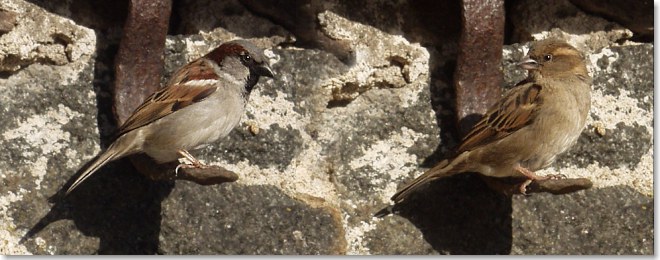How to take part in the detailed survey
run by the RSPB Ipswich Local Group.
Most of the work in this survey finished end of May 2016 - download the Sparrows Of Ipswich final report (PDF)
We are running a small catch-up survey in 2017 to complete some parts we didn't get to last year
Selecting a 350m by 350m survey square
Take a look at the maps showing the survey areas and select one that is available. If you select the marker, you can see more details and sign up
The survey process
We are mapping active nests - the males chirp regularly at the nest site, which is usually at the eaves or gutter level. The idea is to plot a route that covers the publicly accessible roads in the square, and then walk this route, marking the active nests on the map with a N.
What is an active Nest?
An active nest is most commonly observed as a male chirping at the nest site. However either sex entering a potential nest site either with or without nesting material or food also counts as an active nest site
Record other male sparrows
Additional males observed not at nest sites are marked with a S.
Timing and other considerations
Breeding sparrows are more active in the morning - the best time to survey is in the couple of hours after dawn, and the survey should be finished before midday.
Please mark the route taken on the map - it is easier if you plan this before the first visit, and follow the same route in subsequent visits. Some squares will have inaccessible areas, and the route shows us how much of the square has been covered.
We will allocate you an observer number, and if you then select your detailed map square you will see it has become a survey form.
The survey period is the months of April and May, and involves two or three visits (with preferably 10 - 14 day intervals in between), mapping the nests and males mapping the nests and males on two or three separate forms.
The Working Group for Urban Sparrows who drafted the principles say it takes approx. 2 hours to survey a square in suburban habitat, though our surveyors seems to find an hour is enough time.
When you have finished the last survey send a scan by email. Please don't just photograph it with a mobile phone - the resolution is poor and the perspective distortion means the sightings are hard to place. Alternatively send the forms in by post. We will process the data and let you know when the results are available. By the end of May Swifts will arriving, and help with reporting Swift observations would be welcome.
for more detailed instructions and an explanation of the methodology, please click here.
